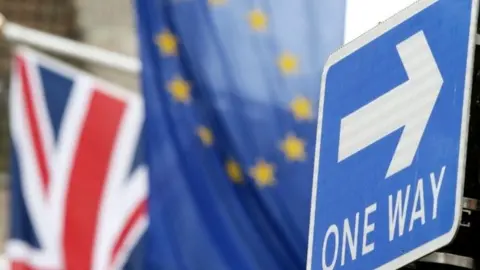At-a-glance: The UK's four Brexit options
 Getty Images
Getty ImagesWith the UK on course to leave the European Union in March next year, the country faces four possible scenarios.
Leave with a deal
The UK and the EU both insist they want as amicable a divorce as possible, with a legal agreement setting out the kind of relationship they will have when the UK is no longer a member of the club.
Prime Minister Theresa May wants to keep close ties with the EU in certain areas, such as trade in agricultural products and allowing skilled migrants access to jobs in the UK.
She says her plan will allow Britain to take back control of its laws, money and borders, just like people voted for in the 2016 EU referendum, while also allowing as "frictionless" trade as possible and avoiding a physical border for Northern Ireland.
But it has been attacked as an unworkable compromise by people from both the Remain and Leave ends of the debate.
The EU may also decide to reject it, but the two sides are still hoping to strike some kind of deal by the autumn and, despite criticism and ministerial resignations, Mrs May believes this is the best option.
Leave without a deal
A clean break with the EU. The UK would fall back on its membership of the World Trade Organization (WTO), the global body governing international trade.
UK exports to the EU would be subject to the same customs checks and taxes the EU currently imposes on countries like the United States.
Those arguing for this option - the so-called "hard Brexiteers" - say it would create a truly independent nation able to strike its own beneficial trade deals around the world.
But opponents say it would be catastrophic for British business and have warned about chaos at the borders, higher food prices and shortages in the shops.
Stay in the EU
The UK has formally triggered the mechanism to leave the EU at 23:00 GMT on 29 March, 2019.
To reverse that at this late stage would mean a huge loss of political face, and probably require a new prime minister, with the backing of voters in a general election.
European Council President Donald Tusk has said he believes Brexit can be halted - but there is some debate about whether the Article 50 process, the two-year legal mechanism taking the UK out of the EU, is reversible. (You can read a full BBC Reality Check on the debate here.)
If the UK did leave and wanted to immediately rejoin, it would need all the other EU member states to agree.
A less formal version of staying in the EU would be if the UK strikes a deal that keeps it in the EU's trade arrangements - the customs union and the single market - and agrees to free movement of people and the jurisdiction of the European Court of Justice. This would amount to staying in the EU, Brexiteers argue.
Hold another referendum
The UK government has ruled this out but there have been a number of people calling for a fresh vote - including Justine Greening.
With Parliament apparently split over what kind of Brexit it wants, a referendum on the final deal agreed by Theresa May in Brussels might yet end up being the only way to break the deadlock.
Those campaigning for another referendum say voters should get the final say, including the option of staying in. Labour's leadership say a general election should be held rather than another referendum.
